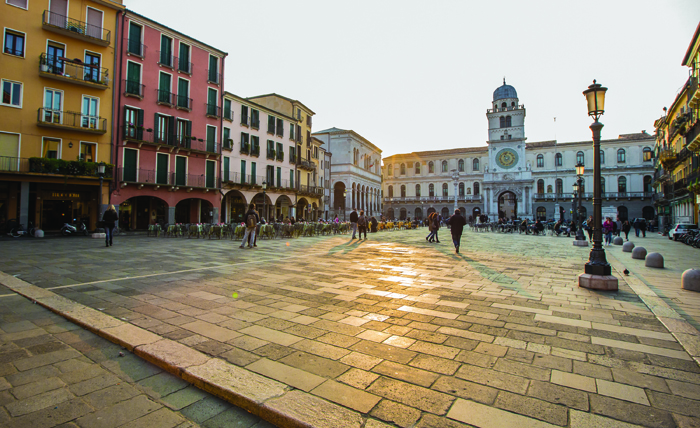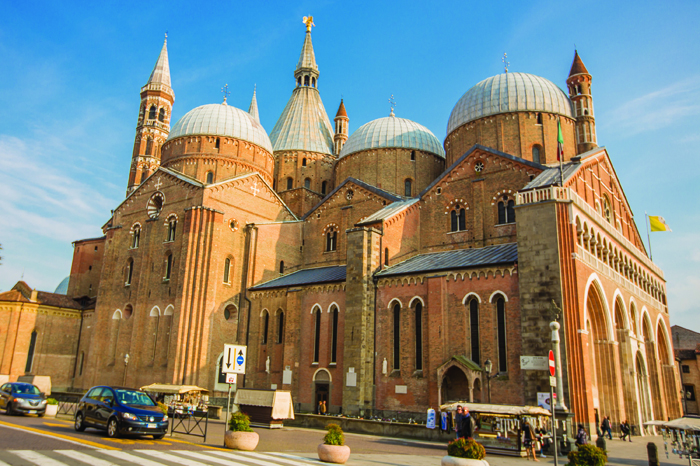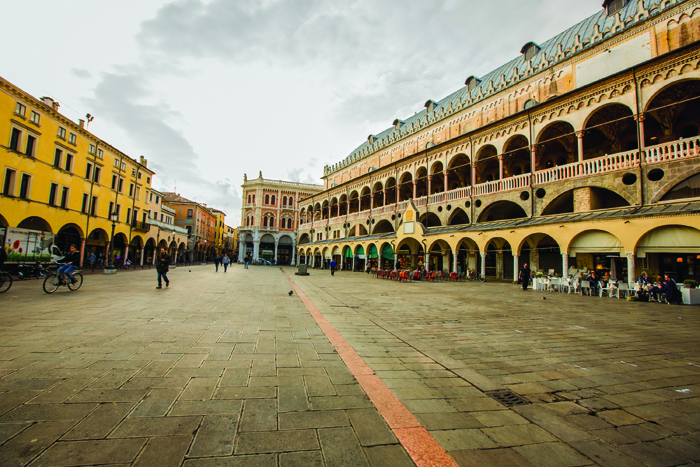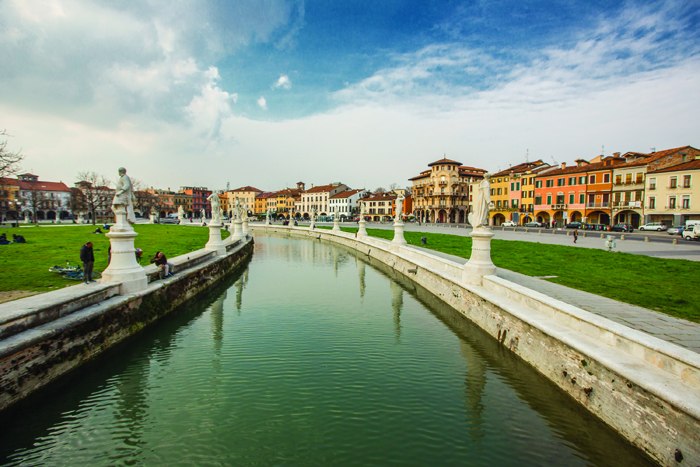Though it can be reached by train from Venice in 25 minutes, Padua is often overlooked by visitors to the northeast of Italy. Sara Scarpa seeks to redress the balance…
When you arrive in Padua from Venice, the one thing that jumps out at you is the energetic buzz of the city. With nearly 60,000 students at the University, there is a sense of optimism that pours out of the wine bars and into the beautiful piazze. It is in places such as Piazza dei Signori, Piazza delle Erbe and Piazza della Frutta that you will find such an atmosphere dominating from the early evening, when the locals meet for the customary aperitivo. Here, you may also overhear the never-ending dispute of whether Spritz all’Aperol, the vibrant orange aperitif, originates from Venice or Padua…
Padua, or Padova, to give the city its Italian name, lies just to the west of Venice, on the road to Vicenza and Verona. Topographically, it sits on the Venetian Plain, between two rivers, the Brenta and the Bacchiglione; to its southwest are the Colli Euganei, the Euganean Hills, an area famous for its stunning villas and, perhaps even more so, for its many vineyards producing great DOC wine and Prosecco. Culturally, Padua is a city of great importance for science and the arts – such greats as Dante, Petrarch, Copernicus, Galileo and Gabriel Fallopius are all associated with the city – and it also a city that remains true to the Italian way of life with stunning food and wine on offer at the many daily markets around the city.
Art lovers might want to spend longer than 48 hours here as the city offers works by Giotto, Donatello, Mantegna and Giusto de’ Menabuoi. Giotto’s floor-to-ceiling frescoes representing scenes from the New Testament, and the blue vault studded with stars in the Scrovegni Chapel, are a wonder to behold.
Padua is, of course, also a pilgrimage city due to being the resting place of St Anthony. Sant’Antonio da Padova was a Franciscan preacher, well known for his sermons, who was canonised in record time in 1232, only ten months after his death. The Basilica of Sant’Antonio, completed in 1310, is one of the most important Christian pilgrimage sites, with thousands of followers flocking to his tomb from all over the world; it is not uncommon to see queues with hundreds of pilgrims clustering along the right transept anxious to press their palms against the Saint’s tomb. The tomb itself is covered with photos and ex-votos (votive offerings) left here to thank the Saint for his intercessions on curing illnesses and in recovering lost objects. Within the square outside St Anthony’s is Donatello’s famous equestrian statue of Gattamelata, ‘the honeyed cat’, the courageous mercenary who fought for Venice and its empire.
Padua is often nicknamed also La Dotta (“The Learned”) or “the Brain of Veneto” for being the site of the second oldest university in Italy (it was established in 1222 when a group of students arrived from Bologna, which was, and is, Italy’s, and Europe’s, first university). You can book a guided tour in the Palazzo del Bo to see the very pulpit from which Galileo taught and also the world’s very first anatomical theatre (1594). Within the lovely courtyard of the University, which is open to the public, you can see the walls decorated with nearly 3,000 ancient coats of arms from the noble families of students and professors. And here, tucked away to the right as you enter the courtyard, you will also see a tribute statue to Elena Lucrezia Cornaro Piscopia which commemorates her being the first woman to graduate from the university – she received her doctoral degree here in 1678.
I always look forward to returning to the heart of Padua, the three main squares – Piazza dei Signori, Piazza delle Erbe and Piazza della Frutta – which really are the life of the city and are almost chameleon-like in form as they provide locals and visitors with delights that change throughout the morning, afternoon and evening. As dawn breaks over the city the squares are occupied by the lively daily market traders offering wonderful fruit, vegetables, flowers and clothes. By midday the markets are quickly replaced by an abundance of locals, who will stop in to the many cafés and osterie dotted around the perimeter of the square. Paduans, like Venetians, often eat cicchetti (a kind of Italian tapas typical of the Veneto), though they call them spuncioni or spunciotti here. Throughout Italy you will be spoilt for choice when it comes to wine but in the heart of Veneto you cannot go wrong with a chilled Prosecco or a classic Soave which (trust me) is on a different level to some of the Soave that is usually found on the bottom shelves of British supermarkets!
One true culinary institution in Padua is La Folperia di Max e Barbara, a simple street stall which is open daily between 4pm to 9pm on the side of Piazza della Frutta. After a warm welcome from Max and Barbara we were treated to a colourful and vibrant plate of fresh folpetto (boiled baby octopus) with a delicious oil, basil and parsley sauce and a pleasant conversation with some of the elderly locals, amongst whom stands the lovely Piero, who has been coming to eat at this stall daily for the last forty years.
In the same square, we then grabbed an ombra and a panino caldo con porchetta (a hot sandwich with roasted pork) at the Bar dei Osei, a simple place popular with locals for its tasty sandwiches. The bar is located just under the porches of the Salone. Sotto il Salone (literally ‘Under the Hall’, as it is just underneath the hall of the palace) is the city’s covered market, under the rooms of the medieval Palazzo della Ragione, which was once the court of the city. The Palazzo stands out among the three squares and is considered a symbol of the city.
Merchants have been trading here since the Middle Ages and there are still many family-owned shops selling salami, meat, fresh fish, handmade pasta and wine. Here, we bought salami and fresh pasta and talked to one of the shop owners, the friendly Paolo Cecchinato, who has been working at his shop for 40 years and who enthusiastically explained to us the story of his shop.
Finally, we walked towards Piazza Cavour for a well deserved mint coffee and a delicious tiramisù at the historical Caffè Pedrocchi, Stendhal’s favourite. On our way to the piazza, near the Palazzo del Bo, we were distracted by a group of people shouting “Dottore, dottore!” They were surrounding a young boy in a ludicrous outfit holding a poster and a plastic bottle full of wine, one of the many new graduates, and a victim of his friends’ pranks… According to students’ traditions, when somebody graduates his friends prepare a big poster (papiro) to hang on buildings, walls or trees to mock the new graduate and they embarrass him publicly and get him drunk. It is a compulsory rite of passage to celebrate the end of university life!
The following day, after having had breakfast at one of the oldest patisseries in town, Pasticceria Graziati, we got a bus from the train station to the nearby Abano Terme (only 7 miles away) to indulge in a day of benessere (wellbeing), pampering ourselves at the famous thermal baths and spas. Abano’s hot springs and mud baths are well known in all Europe thanks to their therapeutic effects and, although initially I was sceptical about having my body encased in mud, after the treatment I felt utterly relaxed and I could not wait to slip into the warm Jacuzzi of ozone-enriched thermal water. Finally, icing on the cake, a regenerative massage!




